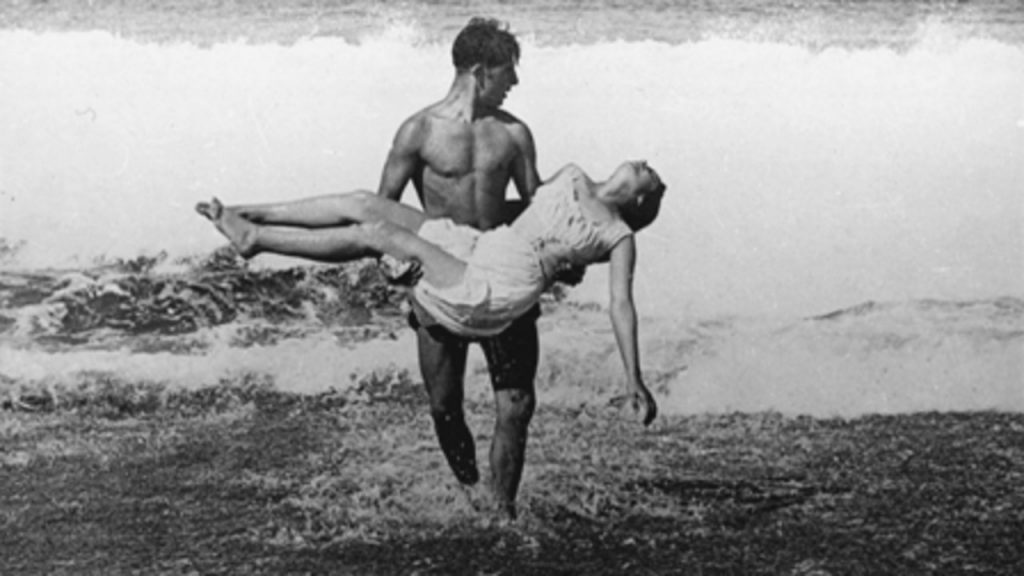Patrick Holzapfel
– What a fitting metaphor for a retrospective about international archival work is a film about a woman being saved from drowning. In cinema, when somebody is saved from drowning like Boudu in Renoir or Madeleine in Hitchcock, a new life and thus fiction might begin. Once somebody is granted with the gift of life, a narrative impossibility suddenly becomes more likely, an ellipsis of time pushes the boundaries and might give ghosts a chance to return, class distinctions to be challenged or love to blossom where there would be only hate otherwise.
– Cinemateca Portuguesa (who by the way have produced the most stunning book on the timeless topic of “cinema and the sea“) send the taste of salt and the sound of waves as one of their gifts to the retrospective. Maria do Mar by Leitão de Barros (1930), a silent film classic of epic scope, is a film deeply rooted in the traditions of the sea and can be seen as a predecessor for the Poèmes bretons by Jean Epstein or films by Luchino Visconti, Roberto Rossellini or Paulo Rocha. It is also rather close to the cinema of Robert Flaherty.

– Usually, we associate popular comedies with early Portuguese cinema. Maria do Mar is not a comedy. It has much more to do with Cinema Novo which evolved more than 30 years later. It is a modern film, yet it is also a very traditional, very catholic film. It is traditional because families come together while praying, it is modern because there is no second one does not feel the presence of faces, gestures and the sea.
– The highly melodramatic story seems to serve as a mere background for the “reality“ of what is filmed. Nevertheless a dramatic sequence of running parents fearing for the health of their child and edited in rapid successions with flashed of the child’s face intercutted moves to tears.
– The film was shot in the fishing town of Nazaré (today famous among surfers for its waves). It uses people from the place as secondary characters and extras, films their parched hands and warm eyes. In a mesmerizing scene the eponymous boat sinks and de Barros lingers on the reactions of black dressed inhabitants, panicking and collapsing in horror while standing on a majestic rock looking at the sea.
– The sinking boat is called Maria do Mar. It is the same name the daughter of Falacha carries. Falacha is made responsible for the death of the mean on the boat. In an unforgettable scene Falacha walks straight into the sea ending his life out of shame. It feels as if the sea sucks him in, awaits him like a pray with mouth wide open. The sea in Maria do Mar is always brutal. A few years later Maria do Mar almost drowns in the sea. A young man saves here. He is the son of one of the dead fishermen. Their families are enemies but they still fall in love…
– Saudade has become a trademark of Portuguese culture. There is not much of it in Maria do Mar. More than that it is a constant attempt to touch bodies, faces, water and sand. It is a film without intellectual distance but it never feels too close.
– As a title informs at the beginning of the film, Maria do Mar was the first film restored in laboratories of Cinemateca Portuguesa in 2000.
– On a more casual note let me quickly note that this has been an extraordinary retrospective of headpieces so far. I haven’t had the time to research on the exquisite headgear but so far Maria do Mar, Lime Kiln Club Field Day and Valkoinen peura are forerunners of a soon to be discovered topic for film scientists around the globe. Of course, these little observations have to do with cinema being able to show us how life was. Something especially politicians should never forget when it comes to the necessity of funding archival work.
Green-muscled ocean
Idol of many arms like an octopus
Convulsive incorruptible chaos
Ordered tumult
Contorted dancer
Surrounding the taut ships
We traversed row on row of horses
Shaking their manes in the trade winds
The sea turned suddenly very young and very old
Revealing beaches
And a people
Of just-created men still the colour of clay
Still naked still in awe
(Sophia de Mello Breyner Andresen, Discovery)
More on Forever Film
Notes on Grauzone (1979, Fredi M. Murer)
Notes on Film and Reality (1942, Alberto Cavalcanti and Ernest Lindgren)
Notes on Yadanabon (1953, Tin Maung)
Notes on White Shadows in the South Seas (1928, W.S. Van Dyke, Robert J. Flaherty)
Notes on 30 Years of Motion Pictures (1927, Otto Nelson, Terry Ramsaye)
Notes on Sånt händer inte här (1950, Ingmar Bergman)
Notes on Valkoinen peura (1952, Erik Blomberg, Mirjami Kuosmanen)
Notes on Lime Kiln Club Field Day (1913, Edwin Middleton, T. Hayes Hunter, Sam Corker Jr.)